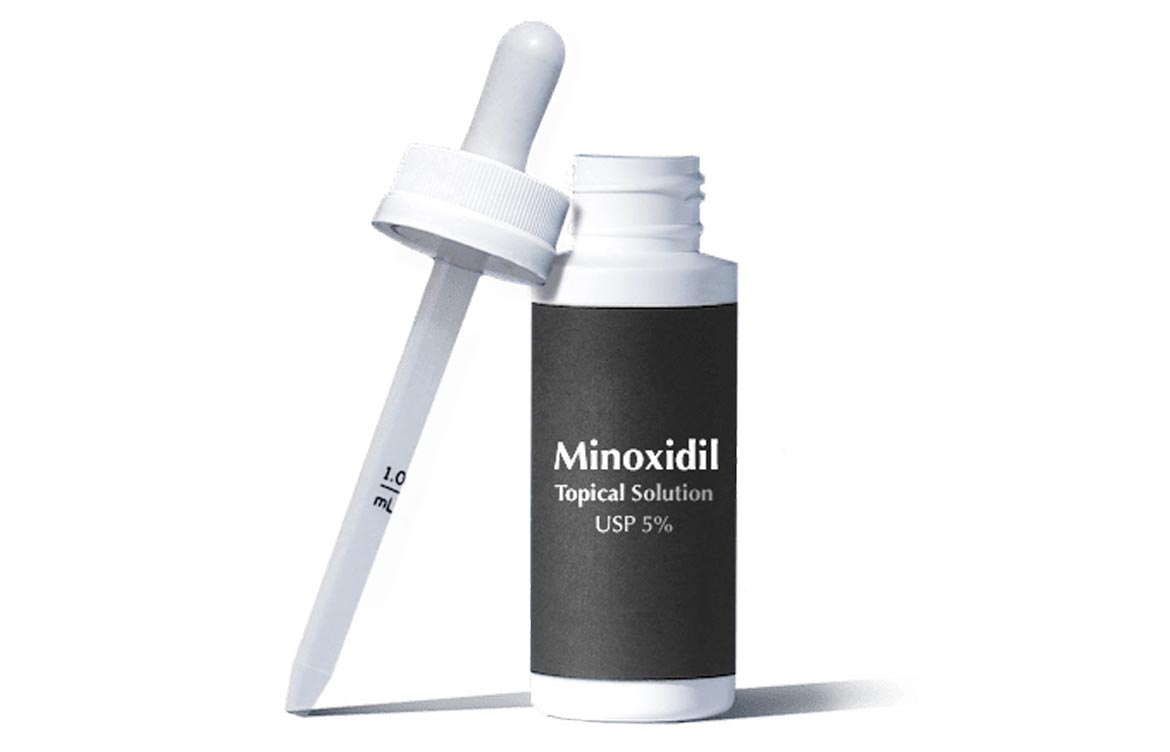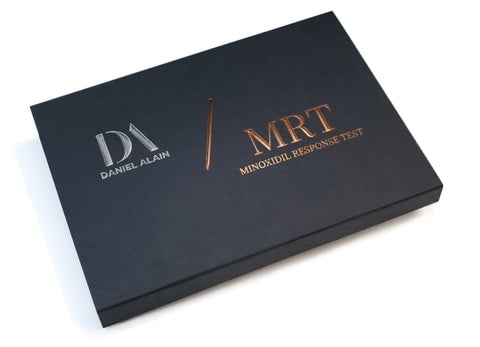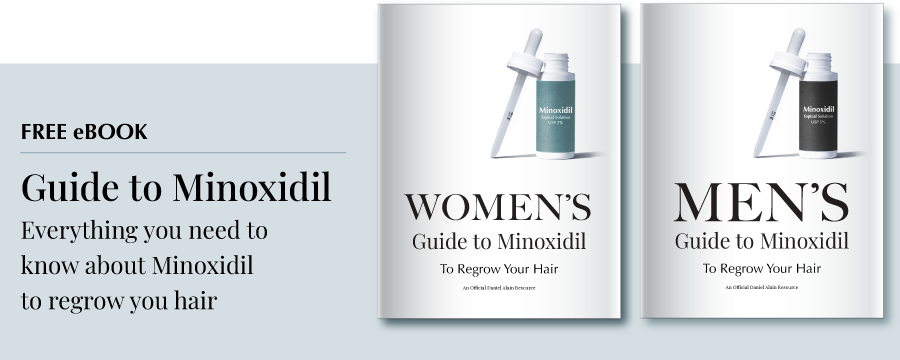Hair Loss Testing | Hair Loss | Men's Minoxidil | Women's Minoxidil
Will Minoxidil Work For Me? What The Latest Science Shows

Minoxidil is an FDA-approved topical treatment intended to stop the progression of hair loss in men and women. However, many people wonder: will Minoxidil work for me?
Until now, people have had to wait months for the treatment to show results, and for many, results never came. However, our hair loss science and research innovations have unlocked a breakthrough that eliminates all mystery of whether Minoxidil will work for you.
Background
Through meticulous research, we’ve discovered the missing puzzle piece in Minoxidil’s effectiveness: the SULT1A1 enzyme, which is necessary to convert and activate Minoxidil. This is a revolution in hair loss solutions because, before this discovery, people had to play the guessing game and wait up to nine months to discover if Minoxidil worked for their hair loss.
Now, we’ve designed the first and only testing to analyze your scalp’s condition and see if you have the enzymes required for Minoxidil to work. Our Minoxidil Response Test for women and for men eliminates the mystery and gets you closer to solutions.
In this article, we’re walking you through every detail of Minoxidil for hair loss to help you discover if the treatment will work for you. Ultimately, we’re here to provide you with a comprehensive overview to save you time, money, and frustration and offer an effective resource to give you answers faster.
How Does Minoxidil Work?
If your hair loss journey led you here, you’re likely dealing with thinning, shedding, balding, or progressive hair loss. Whether you’re in the early or late stages, hair loss is an emotionally taxing issue. Even if you’re doing regular scalp massages, taking hair growth supplements, and prioritizing your scalp health — you’re still losing hair. Sound familiar?
Minoxidil is a topical hair loss treatment that can stimulate regrowth and increase hair density in existing strands. By applying the solution twice daily, some people can see results in a few months to a year. However, the treatment doesn’t work for everyone, which we’ll expand on shortly.
WHAT IS MINOXIDIL?
The hair loss treatment is widely known by its brand name, Rogaine®, which scientists created to treat high blood pressure patients in the 1960s. An unexpected side effect occurred while testing the treatment in clinical trials: some people with hair loss experienced regrowth.
Through this discovery, scientists developed a new topical hair loss solution called Rogaine in 1988. While most people consider Rogaine a men’s hair loss treatment, 1992 opened the door for women experiencing hair loss and female pattern baldness with Rogaine 2% concentration.
Today, the Minoxidil treatment functions primarily as a hair regrowth treatment sold by brands like Keeps, Hers, Hims, Rogaine, Nioxin, and others.
But does Minoxidil actually work? This is where things get tricky.
Many brands answer that question with a simple “yes.” The claim that if Rogaine application led to “moderate” or “minimal” regrowth in clinical trials, it’s considered effective. The question is, how effective?
The results are variable, with response rates falling between 50-60%.
Bottom line: Minoxidil doesn’t work for everyone. For example, those in the early stages of hair loss tend to have more hair to preserve, so the treatment is most useful for people 40 and under. Even so, the hair loss must meet specific parameters.
Minoxidil only works for patients with genetic hair loss who also have the SULT1A1 enzymes.
This is a breakthrough in what we’ve previously understood about Minoxidil because, without these two factors, the treatment won’t work.
Bottom line: Minoxidil doesn’t work for everyone. For example, those in the early stages of hair loss tend to have more hair to preserve, so the treatment is most useful for people 40 and under. Even so, the hair loss must meet specific parameters.
learn more about minoxidil. download our guide.
HOW DOES MINOXIDIL WORK TO REGROW HAIR?
Minoxidil is an FDA-approved over-the-counter topical treatment administered in either 2% solution or 5% solution. For decades the consensus has been that we don’t know precisely how Minoxidil works. As you can imagine, this is a nightmare for consumers.
The narrative has been along the lines of we don't know how this drug works, but why don't you give it a try for 6-9 months and hope for the best?
Not only is the guessing game daunting, but it wastes time and money for those who, up to this point, weren’t qualified candidates.
With our discovery of the SULT1A1 enzyme, we can identify Minoxidil responders from non-responders. Instead of waiting 6-9 months, our Minoxidil Response Test for women and for men can remove the guesswork and tell you if the solution will work for you. The results are validated with 95.9% accuracy, giving you the power to make an informed decision.
So, let’s say your results show you are a candidate for Minoxidil: how does the solution work?
Topical application with a scalp drop or foam formula can dilate the blood vessels on your scalp to accept more growth-stimulating nutrients and oxygen. Additional research finds that Minoxidil increases ATP enzymes within the hair follicles to keep hair in the growth (anagen) phase longer.
The primary goal of Minoxidil for hair loss is to stimulate the hair follicles to grow new hair. Additionally, the solution can strengthen existing hair by increasing strand density and thickness.
But as we’ve learned, there are more pieces to the puzzle.
Finding the Mechanism of Action
Minoxidil is a pro-drug, and for it to work, there must be a specific enzyme present in the hair follicles. So let’s break down what we now know is required for Minoxidil to work.
- Minoxidil needs to react with the scalp to produce minoxidil sulfate, the active ingredient.
- For this reaction to occur, the hair follicles must contain the minoxidil sulfotransferase (SULT1A1) enzyme.
- The scalp needs to have a sufficient supply of necessary enzymes to convert and activate Minoxidil.
Understanding this process is the key to unlock the mystery of the drug. Until now, you’d have no way of knowing if Minoxidil would work for you other than using the product for 6-9 months and waiting around for results.
With the Minoxidil Response Test, you’ll have answers quicker and gain confidence in proceeding with treatment or seeking alternative treatment options for your type of hair loss.

What if the test finds you’re a non-responder? Then you may be experiencing a non-genetic hair loss.
Additional Causes of Hair Loss
With most types of hair loss, there is an underlying cause. Historically, hair loss has been regarded as a men’s issue, but this is entirely false.
For women, various life stages like puberty, menopause, and postpartum can cause temporary hair loss. For men, genetics are the primary cause of hair loss. The condition is called androgenetic alopecia, and it affects 50 million men in the US.
But 30 million US women also experience hereditary hair loss. In fact, some of our favorite female celebs have alopecia, including celeb Keira Knightley.
“It got so bad that my hair literally began to fall out of my head. So for the past five year, I've had to wear wigs, which is the greatest thing that's ever happened to my hair,” Knightley said in an interview with InStyle.
Additional hair loss causes include:
- Medications
- Medical illness
- Alopecia
- Chemotherapy
- Stress
- Extreme dieting
- Environmental influences and pollutants
- Postpartum hair loss
- Menopause
- Thin hair
- Seasonal hair shedding
- Traction and pulling
If you’ve taken the Minoxidil test and discovered you’re a responder, let’s go over what to expect from using the treatment.
HOW LONG DOES IT TAKE FOR MINOXIDIL TO WORK?
Products like Rogaine claim that results can begin to show within 2-3 months. However, in the original FDA study, patients didn’t see results until 6-9 months of consistent application.
In our clinical research, patients with genetic hair loss responded to the topical 5% solution after 3-6 months. But of course, we now know that the patients who saw results must have had the SULT1A1 enzyme.
It’s important to consider that treatment is ongoing. If you stop applying the solution daily, your progress will reverse, and your hair will return to the state it was in when you initially began treatment.
HOW DO I KNOW IF MINOXIDIL IS WORKING?
Because Minoxidil is a topical application applied to the scalp, the treatment starts working immediately. But that doesn’t mean you’ll see results right away. This process is all about the long game. You’ll need to consistently apply the treatment daily before seeing visible results around 3-6 months.
If you’ve applied Minoxidil consistently for 6-9 months with no results, it could be that the product isn’t working for you. This is likely because your hair follicles lack the enzymes required to convert and activate the active ingredient.
If it is working, Minoxidil goes to work on a biological level by dilating the blood vessels in your scalp to transform your scalp’s environment and hair growth cycle. Your hair goes through several phases, first entering into the growth period before shrinking and falling from the hair follicle to make way for new hair.
Unfortunately, new hair doesn’t always grow.
Minoxidil sends more hairs into the growth phase, but first, you’ll notice shedding as the treatment expedites the growth cycle to make way for regrowth.
If you’ve been using Minoxidil and aren’t sure if the treatment is working, look for the following signs:
- Excessive or sudden hair shedding
- Increased hair length
- Greater strand density - fine hair might start to feel thicker
Remember that Minoxidil responds to each person’s biochemistry differently, so try to practice patience if you don’t see results right away. If you’re ready to ditch the waiting game, take the Minoxidil Response Test for women or for men to find out if you have the necessary SULT1A1 enzyme to activate Minoxidil and experience successful hair regrowth with Minoxidil.
SHOULD I USE MINOXIDIL?
It’s a leap to invest in the treatment and commit to ongoing twice-daily applications, especially if you’re unsure if you have the necessary enzymes to activate Minoxidil. Whether you need a solution for temporary hair loss or a lifelong treatment, taking our Minoxidil Response Test will eliminate the guessing game and give you the most direct route to answers.
If the results show that your scalp has the necessary enzymes, then you’ll feel confident in your decision to proceed with Minoxidil treatment. But what if the results show otherwise?
FREQUENTLY ASKED QUESTIONS ABOUT MINOXIDIL
Minoxidil is a safe, FDA-approved hair loss treatment. However, some people using the treatment may experience side effects like an irritated and dry scalp, sensitivity to sunlight, burning and itching on the scalp, and scalp scaling and flaking. In addition, women with color-treated hair tend to experience more side effects like scalp irritation and lightheadedness.
High solutions of 5% may cause excessive hair growth in unwanted places like the cheeks. If you’re taking Minoxidil, always wear sunblock to protect yourself from heightened sun sensitivity. If you experience facial swelling, nausea, chest pain, weight gain, dizziness, or heart palpitations, stop use immediately and seek medical treatment.
Does Minoxidil thicken hair?
Topical application of Minoxidil can open the blood vessels on the scalp to nourish the hair follicles and promote hair growth, but only if your hair loss is genetic and your scalp has the necessary enzymes to respond to treatment. If your hair is thinning from hereditary hair loss, Minoxidil can increase your hair density to make it feel thicker. Additionally, the hair loss treatment can strengthen your existing hair strands while promoting new, denser strands.
Do you have to use Minoxidil forever?
Ongoing use of Minoxidil is required for people with androgenetic alopecia, also known as genetic or hereditary hair loss, because the issue is progressive. If you cease treatment, hair thinning and hair fall will progress over time. Therefore, for effective, prolonged hair loss treatment, it’s recommended to regularly use Minoxidil treatments to minimize hair loss progression.
Will Minoxidil ruin my hair?
No. Many people are reluctant to try Minoxidil for hair loss because they’ve heard a rumor that it will worsen hair loss if you cease treatment. However, this is false. Minoxidil may alter your hair’s density and thickness. However, stopping treatment won’t worsen your hair quality. Instead, your hair will return to the condition it was in when you began the treatment.
Who should not use Minoxidil?
Pregnant women and women who plan on becoming pregnant should not use Minoxidil, as its effects on an unborn baby are unknown. Also unknown are the risks of Minoxidil in infants, so breastfeeding mothers should first consult with their doctor. It’s also not recommended to use Minoxidil to treat children or teenagers under 18. Elderly individuals should consult with a dermatologist first, as it can increase their sensitivity to cold temperatures. Finally, if your hair loss isn’t genetic and you don’t have the necessary enzymes, you should not use Minoxidil.
Does Minoxidil work for everyone?
No. Minoxidil best works for men and women with androgenetic alopecia, a genetic hair loss condition, who also have the required enzymes to respond to the treatment. While the treatment is FDA-approved as a hair loss treatment, not everyone qualifies.
Why isn't Minoxidil working for me?
Minoxidil takes time to show results. You may use the treatment topically for 6-9 months before seeing regrowth or increased hair density. One of the common symptoms is excessive shedding. You might think the treatment isn’t working when it’s actually pushing out old hair strands to make way for new strands entering the Anagen phase (growth phase).
How do I know if Minoxidil will work for me?
If you’re unsure if Minoxidil will work for you, consult with a dermatologist about your medical history and hair loss symptoms. The most direct way to determine if this treatment will work for you is with our Minoxidil Response Test, a patented, lab-based test with 95.9% accuracy. By testing a few strands of your hair, the test can determine if your scalp environment has the enzymes to respond to the treatment.
Can I be tested to see if Minoxidil would work for me?
Absolutely! The Minoxidil Response Test analyzes a few of your hair strands in a lab to evaluate your scalp’s condition and environment. The test is patented, lab-based, and clinically proven to be 95.9% accurate in determining whether you have the necessary enzymes to see results.
How does Minoxidil testing work?
The Minoxidil Response Test evaluates the condition of your scalp environment. Hair growth happens in the hair follicles in the scalp. The test assesses your hair strands in a lab to determine if your scalp has the enzymes necessary to activate and respond to topical application of Minoxidil. You’ll mail in a scalp hair specimen of six hairs from the thinning area of your scalp and receive results within seven days.
How much does Minoxidil testing cost?
Our Minoxidil Response Test costs $139 and can be paid in 4-interest free payments of $35. The upfront costs will ultimately save you time and money from investing in a product you’re unsure will work for you. With the results, you’ll have confidence in Minoxidil treatments, provided the test results determine you’re a candidate.
Where can I get a Minoxidil Response Test?
You can buy a Minoxidil Response Test for women or for men from Daniel Alain, the leading authority on hair loss science and solutions. Our test has 95.9% accuracy and is painless and non-invasive. You’ll receive results in 7 days, and the results are 100% confidential.




